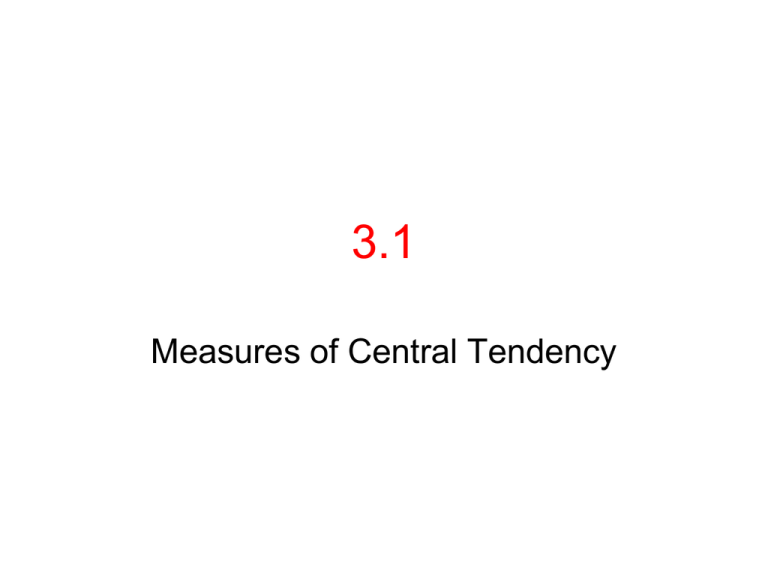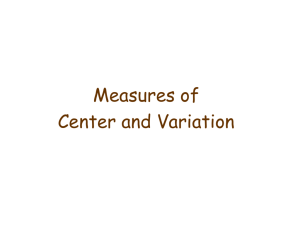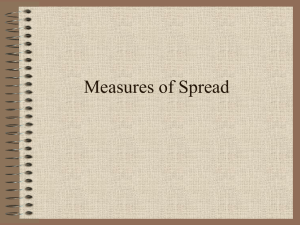
3.1
Measures of Central Tendency
Ch. 3 Numerically Summarizing
Data
• The arithmetic mean of a variable is
computed by determining the sum of all
the values of the variable in the data set
divided by the number of observations.
• The population arithmetic mean is
computed using all the individuals in a
population.
– The population mean is a parameter.
– The population arithmetic mean is denoted by
the symbol μ
Population Mean
• If x1, x2, …, xN are the N observations of a
variable from a population, then the population
mean, µ, is
x1 x2
N
xN
Sample Mean
• The sample arithmetic mean is computed
using sample data.
• The sample mean is a statistic.
• The sample arithmetic mean is denoted by
x
Sample Mean
• If x1, x2, …, xN are the N observations of a
variable from a sample, then the sample mean
is x
x1 x2
x
n
xn
Sample Problem Computing a Population
Mean and a Sample Mean
•
The following data represent the travel times
(in minutes) to work for all seven employees of
a start-up web development company.
23, 36, 23, 18, 5, 26, 43
Compute the population mean of this data.
Median
• The median of a variable is the value that
lies in the middle of the data when
arranged in ascending order. We use M to
represent the median.
3-8
EXAMPLE
Computing a Median of a Data Set with an Odd
Number of Observations
The following data represent the travel times (in minutes)
to work for all seven employees of a start-up web
development company.
23, 36, 23, 18, 5, 26, 43
Determine the median of this data.
EXAMPLE
Computing a Median of a Data Set with an
Even Number of Observations
Suppose the start-up company hires a new employee.
The travel time of the new employee is 70 minutes.
Determine the mean and median of the “new” data set.
23, 36, 23, 18, 5, 26, 43, 70
3-10
EXAMPLE
Computing a Median of a Data Set with an
Even Number of Observations
The following data represent the travel times (in minutes) to
work for all seven employees of a start-up web development
company.
23, 36, 23, 18, 5, 26, 43
Suppose a new employee is hired who has a 130 minute
commute. How does this impact the value of the mean and
median?
3-11
EXAMPLE
Computing a Median of a Data Set with an
Even Number of Observations
The following data represent the travel times (in minutes) to
work for all seven employees of a start-up web development
company.
23, 36, 23, 18, 5, 26, 43
Suppose a new employee is hired who has a 130 minute
commute. How does this impact the value of the mean and
median?
Mean before new hire: 24.9 minutes
Median before new hire: 23 minutes
Mean after new hire: 38 minutes
Median after new hire: 24.5 minutes
3-12
Resistance
• A numerical summary of data is said to be
resistant if extreme values (very large or
small) relative to the data do not affect its
value substantially.
3-14
EXAMPLE
Describing the Shape of the Distribution
The following data represent the asking price of homes
for sale in Lincoln, NE.
79,995
99,899
105,200
128,950
130,950
131,800
149,900
151,350
154,900
189,900
203,950
217,500
111,000
120,000
121,700
132,300
134,950
135,500
159,900
163,300
165,000
260,000
284,900
299,900
125,950
126,900
138,500
147,500
174,850
180,000
309,900
349,900
Source: http://www.homeseekers.com
3-15
Sample Problem
• Find the mean and median. Use the mean
and median to identify the shape of the
distribution. Verify your result by drawing
a histogram of the data.
Find the mean and median. Use the mean
and median to identify the shape of the
distribution. Verify your result by drawing a
histogram of the data.
The mean asking price is $168,320 and the
median asking price is $148,700. Therefore, we
would conjecture that the distribution is skewed
right.
3-17
Asking Price of Homes in Lincoln, NE
12
10
Frequency
8
6
4
2
0
100000
150000
200000
250000
Asking Price
300000
350000
3-18
Mode
• The mode of a variable is the most
frequent observation of the variable that
occurs in the data set.
• If there is no observation that occurs with
the most frequency, we say the data has
no mode.
– The data on the next slide represent the Vice
Presidents of the United States and their state
of birth. Find the mode.
3-20
-21
Tally data to determine most
frequent observation
3-22
One-Variable Statistics Nspire
1. Create a list &
spreadsheets page
2. Title column
3. Enter data into
column
4. Create a calculator
page
5. Click Menu
6. 6:Statistics
–
–
1:Stat Calculations
1: One-Variable Stats
𝑥 = mean
Sx = sample S.D.
σx = population S.D.
Record min, Q1,
Median, Q3, Max
Practice Problem
• The following is a list
of pulse rates for nine
students enrolled in a
section of statistics.
Determine the mean,
median, & mode of
the data set using
technology.
76
60
60
81
72
80
80
68
73
3.2
Measures of Dispersion
Range
• The range, R, of a variable is the
difference between the largest data value
and the smallest data values. That is
• Range = R =
Largest Data Value – Smallest Data Value
EXAMPLE Finding the Range of a Set of Data
The following data represent the travel times (in minutes)
to work for all seven employees of a start-up web
development company.
23, 36, 23, 18, 5, 26, 43
Find the range.
Population Variance
• The population variance of a variable is
the sum of squared deviations about the
population mean divided by the number of
observations in the population, N.
• That is it is the mean of the sum of the
squared deviations about the population
mean. It let’s us know how spread out data
is from the average.
The population variance is symbolically represented
by σ2 (lower case Greek sigma squared).
Note: When using the above formula, do not round until the
last computation. Use as many decimals as allowed by your
calculator in order to avoid round off errors.
3-29
EXAMPLE
Computing a Population Variance
The following data represent the travel times (in minutes) to
work for all seven employees of a start-up web development
company.
23, 36, 23, 18, 5, 26, 43
Compute the population variance of this data. Recall that
174
24.85714
7
xi
μ
xi – μ
(xi – μ)2
23
36
23
18
24.85714
24.85714
24.85714
24.85714
-1.85714
11.14286
-1.85714
-6.85714
3.44898
124.1633
3.44898
47.02041
5
26
43
24.85714
24.85714
24.85714
-19.8571
1.142857
18.14286
394.3061
1.306122
329.1633
x
i
2
x
i
N
2
2
902.8571
902.8571
129.0 minutes2
7
-31
Sample Variance
• The sample variance is computed by
determining the sum of squared deviations
about the sample mean and then dividing
this result by n – 1.
Note: Whenever a statistic consistently overestimates or
underestimates a parameter, it is called biased. To obtain an
unbiased estimate of the population variance, we divide the
sum of the squared deviations about the mean by n - 1.
33
The population standard deviation is denoted by
It is obtained by taking the square root of the population
variance, so that
The sample standard deviation is denoted by
s
It is obtained by taking the square root of the sample variance, so
that
s s2
3-34
EXAMPLE
Computing a Population Standard
Deviation
The following data represent the travel times (in minutes) to work
for all seven employees of a start-up web development company.
23, 36, 23, 18, 5, 26, 43
Compute the population standard deviation and variance of this data
using technology.
3-35
One-Variable Statistics Nspire
1. Create a list &
spreadsheets page
2. Title column
3. Enter data into
column
4. Create a calculator
page
5. Click Menu
6. 6:Statistics
–
–
1:Stat Calculations
1: One-Variable Stats
𝑥 = mean
Sx = sample S.D.
σx = population S.D.
Record min, Q1,
Median, Q3, Max
3-37
3-38
EXAMPLE Using the Empirical Rule
The following data represent the serum HDL
cholesterol of the 54 female patients of a family
doctor.
41
62
67
60
54
45
48
75
69
60
54
47
43
77
69
60
55
47
38
58
70
61
56
48
35
82
65
62
56
48
37
39
72
63
56
50
44
85
74
64
57
52
44
55
74
64
58
52
44
54
74
64
59
53
3-39
(a) Compute the population mean and standard
deviation.
(b) Draw a histogram to verify the data is bellshaped.
(c) Determine the percentage of patients that have
serum HDL within 3 standard deviations of the
mean according to the Empirical Rule.
(d) Determine the percentage of patients that have
serum HDL between 34 and 69.1 according to the
Empirical Rule.
(e) Determine the actual percentage of patients
that have serum HDL between 34 and 69.1.
3-40
(a) Using a TI-nspire graphing calculator, we find
57.4 and 11.7
(b)
© 2010 Pearson Prentice Hall. All rights reserved
3-41
(c) Determine the percentage of patients that have serum HDL
within 3 standard deviations of the mean according to the
Empirical Rule.
(d) Determine the percentage of patients that have serum
HDL between 34 and 69.1 according to the Empirical Rule.
(e) Determine the actual percentage of patients that have
serum HDL between 34 and 69.1. (look back at original data!)
One measure of intelligence is the Stanford-Binet Intelligence
Quotient (IQ). IQ scores have bell-shaped distribution with a
mean of 100 and a standard deviation of 15
A. What percentage of people has an IQ score between
70 and 130?
B. What percentage of people has an IQ score less than
70 or greater than 130?
C. What percentage of people has an IQ score below 85?
3.4
Measures of Position and Outliers
The Z-Score
EXAMPLE Using Z-Scores
The mean height of males 20 years or older is 69.1 inches
with a standard deviation of 2.8 inches. The mean height
of females 20 years or older is 63.7 inches with a standard
deviation of 2.7 inches. Data based on information
obtained from National Health and Examination Survey.
Who is relatively taller?
Kevin Garnett whose height is 83 inches
or
Candace Parker whose height is 76 inches
3-46
Sample Problem
• Score on ACT was 26 with a mean of 22
and sd of 3. Score on SAT was 950 with
mean of 925 and sd of 25. Which score is
"better"?
Quartiles divide data sets into fourths, or four equal parts.
• The 1st quartile, denoted Q1, divides the bottom 25% the
data from the top 75%. Therefore, the 1st quartile is
equivalent to the 25th percentile.
• The 2nd quartile divides the bottom 50% of the data from the
top 50% of the data, so that the 2nd quartile is equivalent to
the 50th percentile, which is equivalent to the median.
• The 3rd quartile divides the bottom 75% of the data from the
top 25% of the data, so that the 3rd quartile is equivalent to
the 75th percentile.
3-48
3-49
EXAMPLE
Finding and Interpreting Quartiles
A group of Brigham Young University—Idaho students (Matthew
Herring, Nathan Spencer, Mark Walker, and Mark Steiner) collected
data on the speed of vehicles traveling through a construction zone on
a state highway, where the posted speed was 25 mph. The recorded
speed of 14 randomly selected vehicles is given below:
20, 24, 27, 28, 29, 30, 32, 33, 34, 36, 38, 39, 40, 40
Find and interpret the quartiles for speed in the construction zone. In
addition find the mean, median, and standard deviation. (using
technology)
3-50
Interpretation:
• 25% of the speeds are less than or equal to the first quartile, 28 miles
per hour, and 75% of the speeds are greater than 28 miles per hour.
• 50% of the speeds are less than or equal to the second quartile, 32.5
miles per hour, and 50% of the speeds are greater than 32.5 miles per
hour.
• 75% of the speeds are less than or equal to the third quartile, 38
miles per hour, and 25% of the speeds are greater than 38 miles per
hour.
3-51
Interquartile Range
3-52
EXAMPLE
Determining and Interpreting the
Interquartile Range
Determine and interpret the interquartile range of the speed data.
Q1 = 28
Q3 = 38
IQR Q3 Q1
38 28
10
The range of the middle 50% of the speed of cars traveling through the
construction zone is 10 miles per hour.
3-53
Suppose a 15th car travels through the construction zone
at 100 miles per hour. How does this value impact the
mean, median, standard deviation, and interquartile
range?
With Out 15th Car With 15th Car
Mean
Median
Standard Deviation
IQR
Which measures should we report now?
When we add the 15th car which changes less – the mean or median (measures of
center)?
When we add the 15th car which changes les – the standard deviation or the IQR
(measures of dispersion)?
3-54
Suppose a 15th car travels through the construction zone at 100 miles per
hour. How does this value impact the mean, median, standard deviation, and
interquartile range?
Without 15th car
With 15th car
Mean
32.1 mph
36.7 mph
Median
32.5 mph
33 mph
Standard deviation
6.2 mph
18.5 mph
IQR
10 mph
11 mph
3-55
Outliers
EXAMPLE
Determining and Interpreting the
Interquartile Range
Check the speed data for outliers.
Step 1: The first and third quartiles are Q1 = 28 mph and Q3 = 38 mph.
Step 2: The interquartile range is 10 mph.
Step 3: The fences are
Lower Fence = Q1 – 1.5(IQR)
Upper Fence = Q3 + 1.5(IQR)
= 28 – 1.5(10)
= 38 + 1.5(10)
= 13 mph
= 53 mph
Step 4: There are no values less than 13 mph or greater than 53 mph.
Therefore, there are no outliers.
3-57
Sample Problem
• For the following data
of rainfall for Chicago,
IL determine the
following:
1. The Quartiles &
Median
2. The IQR
3. Determine if there
are any outliers.
.97
2.47
3.94
4.11
5.79
1.14
2.78
3.97
4.77
6.14
1.85
3.41
4.00
5.22
6.28
2.34
3.48
4.02
5.50
7.69
3.5
5-Number Summary and BoxPlots
5-Number Summary
EXAMPLE
Constructing a Boxplot
Every six months, the United States Federal Reserve Board conducts a survey of
credit card plans in the U.S. The following data are the interest rates charged by
10 credit card issuers randomly selected for the July 2005 survey. Draw a boxplot
of the data.
Institution
Pulaski Bank and Trust Company
Rate
6.5%
Rainier Pacific Savings Bank
12.0%
Wells Fargo Bank NA
14.4%
Firstbank of Colorado
14.4%
Lafayette Ambassador Bank
14.3%
Infibank
13.0%
United Bank, Inc.
13.3%
First National Bank of The Mid-Cities
13.9%
Bank of Louisiana
Bar Harbor Bank and Trust Company
9.9%
14.5%
Source:
http://www.federalreserve.gov/pubs/SHOP/survey.htm
3-61
Step 1: The interquartile range (IQR) is 14.4% - 12% = 2.4%. The lower and
upper fences are:
Lower Fence = Q1 – 1.5(IQR)
Upper Fence = Q3 + 1.5(IQR)
= 12 – 1.5(2.4)
= 14.4 + 1.5(2.4)
= 8.4%
= 18.0%
Step 2:
*
[
]
3-62
The interest rate boxplot indicates that the distribution is skewed left.
3-63
TI-nspire – Creating a BoxPlot
• See handout
• Use the Nspire calculator to create a
boxplot of the rainfall data from 3.4 data.
.97
2.47
3.94
4.11
5.79
1.14
2.78
3.97
4.77
6.14
1.85
3.41
4.00
5.22
6.28
2.34
3.48
4.02
5.50
7.69










